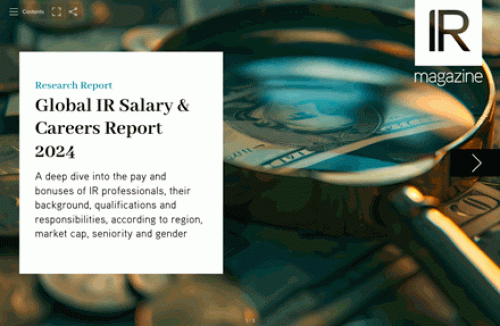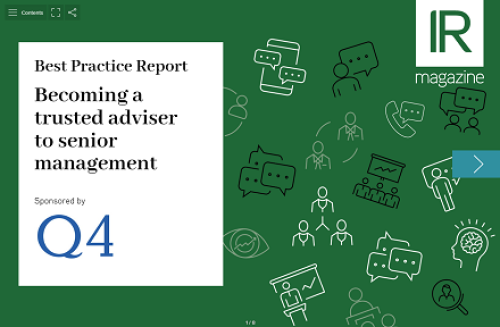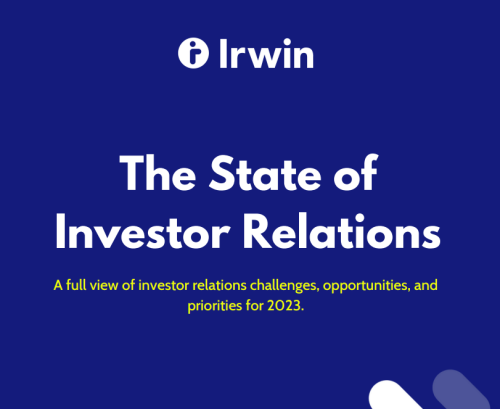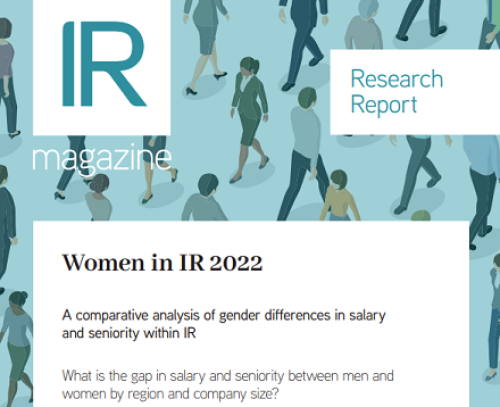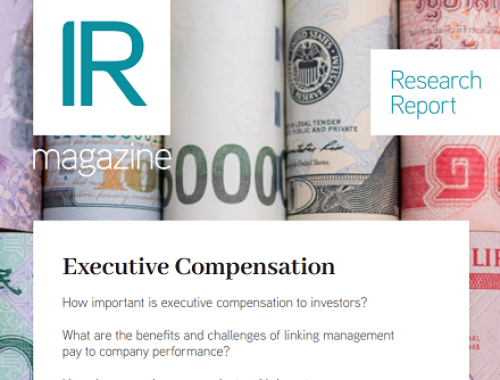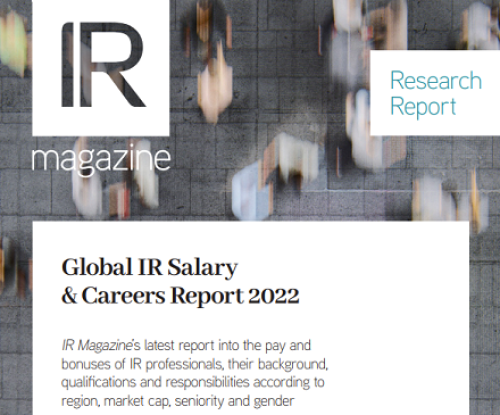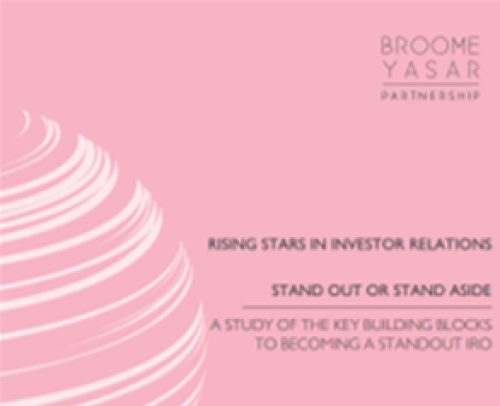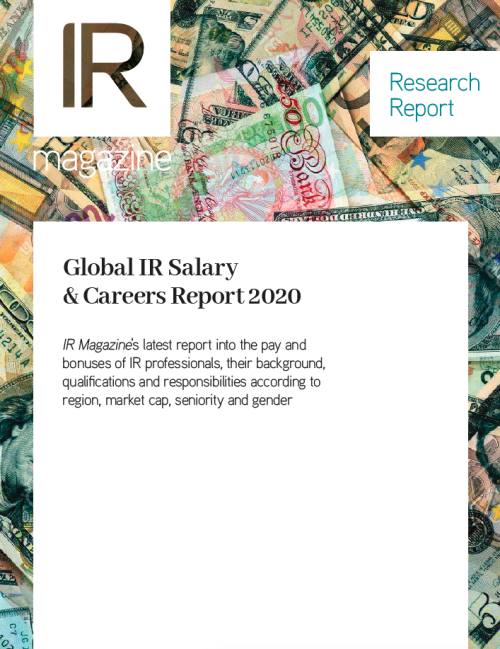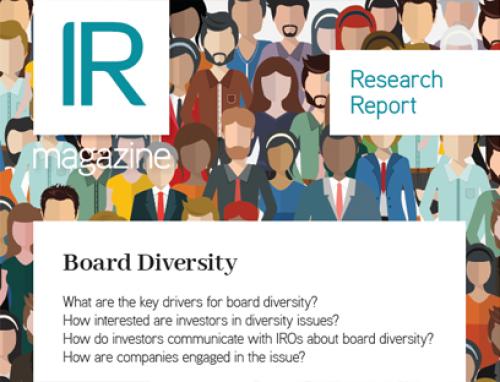An examination of the benefits and pitfalls of rotational investor relations positions
Some CEOs and CFOs at General Electric’s (GE) major business divisions have spent two or three years rotating through IR, serving as the mega-cap company’s top conduit to investors.
Trevor Schauenberg, GE’s vice president of corporate investor communications, landed in the top IR spot after 20 years at the company and CFO stints in transportation and at GE Capital businesses.
For him, the role meant instant exposure to shareholders. ‘Within a week or two of arriving in IR, I was immediately off to see the Olympics with four of our top investors,’ he recalls.
Communicating externally is a large part of the appeal of an IR rotation. ‘Although I dealt with customers in previous CFO roles, it was a small part of the job,’ says Schauenberg.
‘In this role, 80 percent of what I do is meeting with large investors and going overseas to sell-side conferences. I think that gives me a front-end focus that will help during my career.’
IR rotation programs have been around for almost as long as the profession, with promising executives taking their turn at communicating with analysts and institutional investors.
Typically these programs flourish at large companies with multi-person IR teams, where the chance to take in the lessons of investor relations constitutes an important career development move.
‘Speaking with shareholders provides a future CFO with a very important perspective in terms of understanding perceptions and how the analysts and investors think,’ points out Roger Pondel, CEO of Los Angeles-based IR company PondelWilkinson.
Nathan Elwell, managing director at FTI Consulting in Chicago, agrees that being chosen for an IR rotation helps a financial executive develop professionally. He also believes it represents an enormous vote of confidence.
‘It shows you’re considered a well-rounded individual, and that you can do both the finance and communications sides,’ he says. ‘It’s definitely a pat on the back.’
At GE, the top IR job has proven a stepping stone to bigger and better things. Schauenberg notes that of the last six IR leaders, five are still with the company, and all of them are part of the corporate executive council, making them among the top 40 individuals who help chairman and CEO Jeffrey Immelt and CFO Keith Sherin lead the business.
Gaining fresh perspectives
Whereas GE rotates some of its highest-ranking IR professionals, other IR rotation programs serve as a training ground for the young, the energetic and the promising.  At TD Bank, for instance, roughly half of the 10-person IR team participates in an informal rotation, according to Rudy Sankovic, senior vice president of investor relations.
At TD Bank, for instance, roughly half of the 10-person IR team participates in an informal rotation, according to Rudy Sankovic, senior vice president of investor relations.
‘Our hiring mind set involves bringing in really young, talented people, showing them how the bank operates for a couple of years and then letting them move into different roles,’ he explains. ‘We’re a better team for having a bunch of people with many varied backgrounds.’
Indeed, one of the most compelling arguments for rotation programs is the ability to harness fresh perspectives. ‘Investors get to meet and interact with people who have a good deal of industry and corporate knowledge, as opposed to a firm bringing in an IR person from outside,’ says Elwell.
Cole Lannum, vice president of IR at Covidien, emphasizes that, in general, investor feedback on his company’s IR rotation has been positive. ‘Investors like the interaction and appreciate the different perspectives that come from the folks in the assignment,’ he says.
The downside of having lots of different voices speak for investor relations is that the function can feel like a revolving door. ‘IR has a fairly rare skill set,’ says Elwell.
‘If you continue to rotate people every two or three years, you’ll get one or two great candidates, but the odds are that you’ll get one or two duds as well – and what happens to your IR program or your stock price during that period?’
Perhaps for this reason, there’s evidence that IR rotation programs are declining in popularity. In CIRI’s 2010 investor relations compensation and responsibilities survey, 81 percent of respondents say the senior IR role was a career position, not a rotational one.
In departments of two or more IR professionals, however, there is a roughly 50/50 split between those who view the less senior positions as career roles and those who see them as rotational slots.
Similarly, the NIRI-Korn/Ferry International corporate investor relations compensation survey carried out in May 2010 found that the head of the IR function is considered a rotational position at just 7 percent of participating companies, against 20 percent for staff-level IR positions.
How to make it work
In GE’s eight-person IR team, where the rotational IR spots are quite senior, five individuals typically rotate out after three to five years.
Usually financial executives arrive in the department with a wealth of experience, having served as CFO in one or more of GE’s businesses, says Schauenberg. It follows, then, that finding enough suitably qualified internal candidates for IR roles is no mean feat – even for conglomerates the size of GE.
Elwell notes that the job not only requires in-depth knowledge of how balance sheets and income statements work, but also demands someone with a good personality.
‘You can’t be a stereotypical back-office, number-crunching type of individual,’ he explains. ‘You need to be able to communicate, both verbally and in writing. You really need to be able to use both sides of your brain.’
The flip side is that a rotational position in IR has to be seen as an attractive career step for these high-flying finance stars.
Lannum maintains that the biggest challenge for rotational posts at his firm is ‘getting candidates to understand how an assignment could benefit their careers and broaden their exposure to Covidien’s global business operations’.
So far, the two individuals who have completed the rotation have gone on to vice president of finance roles.
The job description for an IR rotation spot can also vary from company to company, beginning with the length of service required by the IR team.
There is no hard and fast rule for how long rotations should last; the industry standard appears to be two to three years, but Elwell cautions against making the rotation periods too brief.
‘If the person transitions into the role, then for the first half of the period he or she is there it’s like a presidency,’ he explains. ‘You’re already in election mode for your next role by the time you’re three quarters of the way through.’
Multi-tasking
Then there are the other parameters of the position. At BP, the rotational post usually entails serving as project manager for the earnings and strategy presentation. Nick Wayth, who heads the oil giant’s North American investor relations team, points out that there is only one two-to-three-year rotational position on BP’s nine-person IR team, and it’s almost always based in London.
‘BP is very concerned about continuity and relationships, and those aren’t things you can achieve by cycling through rapidly,’ says Wayth. ‘So while we’re not all handcuffed for life to the investor relations team, there’s a bias toward having people outside the rotational position stay for at least five years and build strong relationships.’
At TD Bank, individuals rotating through IR try their hands at many different tasks. ‘We strive to have people do a lot of things in the department as opposed to focusing on one specialty,’ says Sankovic.
Sankovic acknowledges that a potential downside to rotational programs is a lack of continuity for investors – and the risk that institutional knowledge might get lost in the shuffle. To guard against this happening, the company has a number of career spots that serve as ‘anchors’.
Equally, Schauenberg notes that JoAnna Morris, GE’s director of corporate investor communications, provides stability by having been in the IR department for more than 20 years. ‘She’s our number one lieutenant and our domain leader, and she helps with the transitions when new people come in,’ he explains.
What the future holds
Individuals rotating out of IR spots can be a terrific resource for the IR department for many years to come. ‘Our alumni are a pretty close group,’ says Schauenberg, noting that he talks with former heads of IR on a quarterly, if not monthly, basis.
What’s more, the rotational stint may not be a temporary position after all. True, the typical IR professional on rotation may spend just a handful of years in the job, but sometimes that’s enough time for that individual to discover a passion for the field and end up staying longer than planned.
Wayth, who arrived in BP’s London rotation program after working in the company’s upstream business, has now spent five and a half years on the team. ‘For me, investor relations has become a longer-term career choice,’ he says.
As the investor relations profession has matured, so have rotation programs. ‘Ten years ago, you rotated people through IR because you didn’t have a good group of people who were career IROs,’ says Elwell. ‘IR as a discipline has grown up in the last 15 years, and it’s now a career option for quality Wall Street people.’
The result? Companies embracing rotation programs today are doing so not out of a dearth of good candidates but because they appreciate the rewards such programs bring.
US and them: comparing the best IROs in the US and CanadaThe US and Canada have much more in common than a border crossing. In IR terms, the attitudes of the top IR professionals in both countries, polled by IR Insight over the last 12 months, coalesce around similar viewpoints of the profession. For instance, 60 percent of the best US IROs and 57 percent of the best Canadian IROs – as determined by the IR Magazine Awards over the last five years – feel their jobs have changed since the 2008 financial crisis, and in both countries the biggest challenges come from short-term investors and management.Then there are the remarkably similar CVs. Three quarters of US IROs have a finance or finance-related background compared with 67 percent in Canada. On average, IROs in Canada spend two and a half years in the profession before becoming head of IR; it’s three years in the US. Gender splits are virtually the same, too: 62 percent male in the US, 60 percent male in Canada. There are some notable differences, however. When asked where they would like to be in five years’ time, nearly a third (31 percent) of US IROs said IR; nearly a quarter (23 percent) admitted to having a keen eye on a CFO position or at least an operational role. In Canada, meanwhile, almost four fifths (78 percent) of top IROs aim to still be in IR in five years’ time. More than half (54 percent) of top IROs in the US have an MBA compared with only one in five Canadian IROs. These findings seem to suggest IR is viewed as more of a career north of the border but little more than a stepping stone due south. Then again, it might just be the case that the best IROs in the US tend to be slightly older than their Canadian counterparts. The average age of an IRO when he or she is appointed head of an IR team is 38 in the US and 35 in Canada. The youngest person to be appointed head of a team was in Canada, at age 23, compared with age 27 in the US. Meanwhile, the oldest person to be appointed head of IR was in the US, at 52 years old compared with 49 in Canada. Indeed, it is perhaps even more telling that the most popular response in the US to the question of where the IRO wants to be in five years was ‘retired’. |

